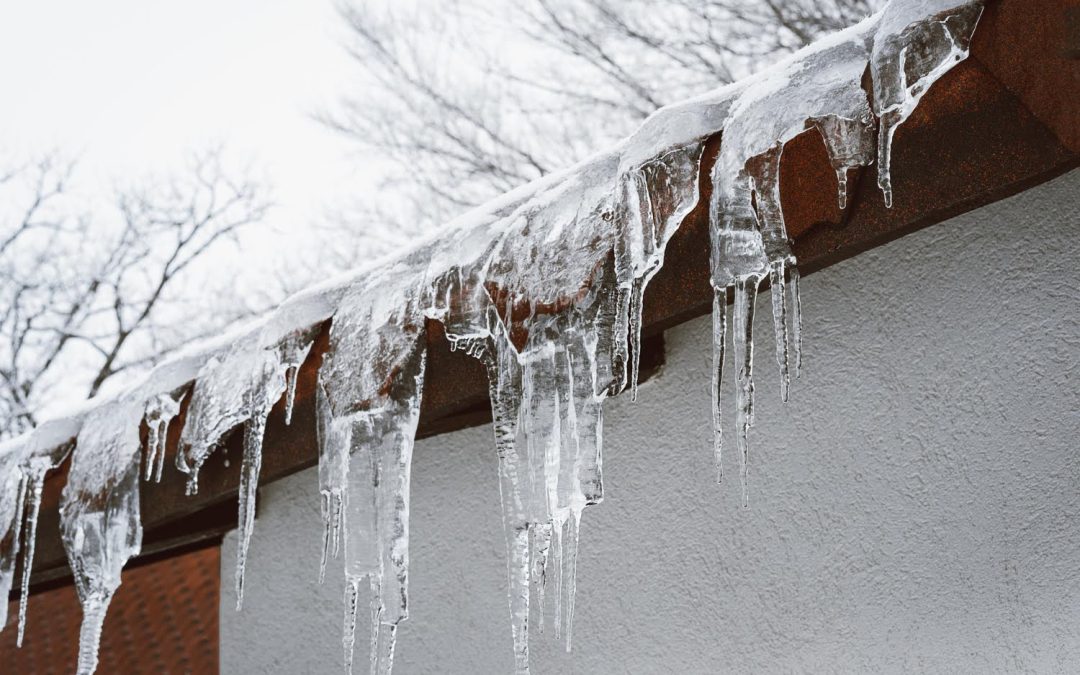As winter’s chill sets in, homeowners in colder regions often face a common yet perplexing problem: ice damming.
Ice dams form primarily as a result of heat escaping from the house and warming specific areas of the roof, leading to non-uniform temperatures. This can lead to significant damage to your home if not properly managed.
In this guide, we’ll explore the causes of ice damming, how to prevent it, and effective solutions to protect your home.
What is Ice Damming?
Ice damming occurs when a ridge of ice forms at the edge of a roof, preventing melting snow from draining off the roof. The water that backs up behind the dam can leak into a home, causing damage to walls, ceilings, insulation, and other areas.
Causes of Ice Damming
Several factors contribute to the formation of ice dams, including:
- Snow Accumulation: A heavy layer of snow on the roof provides the raw material for ice dams.
- Roof Temperature Variations: When the upper part of the roof is above freezing while the lower part is below freezing, melting snow runs down the roof and refreezes when it reaches the colder eaves.
- Inadequate Insulation and Ventilation: Heat escaping from the attic due to poor insulation warms the roof’s surface, while the eaves remain cold, creating an ideal environment for ice dams to form.
Warning Signs of Ice Dams
Ice dams can be a serious issue for homeowners, especially in areas with heavy snowfall and freezing temperatures. Knowing the warning signs of ice dams can help you take action before they cause significant damage to your roof and home.
Unfortunately, while icicles can look picturesque, they often indicate that ice dams are forming. The presence of icicles suggests that melting snow is refreezing at the roof’s edge, leading to ice buildup.
You’ll also want to pay close attention to ice accumulation around vents, chimneys, and skylights; these areas are prone to ice dams due to temperature variations and might lead to significant roof damage. Similarly, if you notice water stains or leaks inside your home, it could be a sign that an ice dam is preventing melting snow from draining properly.
Always remember to inspect your gutter system, as well. When gutters or downspouts are clogged with ice and snow, it prevents proper drainage and can contribute to ice dam formation.
How to Prevent Ice Damming
Preventing ice dams involves addressing the root causes: insulation, ventilation, and roof temperature.
- Proper Attic Insulation: Ensure that your attic is well-insulated to prevent warm air from escaping and melting snow on the roof. This helps maintain a consistent roof temperature, reducing the risk of ice dam formation.
- Roof Ventilation: Install roof vents or ensure that your existing vents are functioning properly to allow warm air to escape and prevent ice buildup. Proper ventilation helps keep the roof surface cold, preventing snow from melting unevenly.
- Gutter Guards: Install gutter guards to prevent debris and snow from entering your gutters and causing ice dams. This ensures that water can flow freely, reducing the risk of ice buildup.
- Regular Maintenance: Regularly inspect and maintain your roof, gutters, and downspouts to ensure they are functioning properly and not contributing to ice dam formation. Clear any debris and check for damage that could lead to ice dams.
- Snow Removal: Remove snow from your roof regularly, especially after heavy snowfall, to prevent ice dams from forming. Using a roof rake can help you safely remove snow from the roof’s edge, reducing the amount of melting snow that can refreeze.
- Seal Air Leaks: Identify and seal any gaps or openings where warm air can escape from the living spaces into the attic. This includes around chimneys, light fixtures, and vents.
- Install Heat Cables: Heat cables or de-icing cables can be installed along the roof’s edge to melt ice and snow, preventing ice dam formation.
Effective Methods for Removing Ice Dams
If you find yourself facing this issue, it’s important to act quickly. Start by removing snow from the roof using a roof rake. Carefully clear the snow from the roof’s edge to minimize the amount of melting snow that can refreeze and form an ice dam. Be cautious not to use sharp tools that might damage the shingles!
Next, focus on melting the ice dam itself. You can create channels through the ice to allow water to drain by filling a pair of pantyhose with calcium chloride ice melter and laying it across the ice dam. This method will gradually melt the ice, providing a pathway for water to escape.
DIY vs. Professional Removal
Removing ice dams can be a challenging and potentially hazardous task. While some homeowners may attempt to remove ice dams themselves, it’s often recommended to hire a professional service.
DIY Removal
Pros
- Cost-Effective: Removing ice dams yourself can save money.
- Quick Action: You can address the problem immediately.
Cons
- Risk of Injury: There is a significant risk of injury from falling ice or slipping on the roof.
- Potential for Further Damage: Using improper tools or techniques can damage your roof or gutters.
- Limited Effectiveness: DIY methods may not completely remove the entire ice dam, leading to recurring issues.
Professional Removal
Pros
- Safe and Effective: Professionals use specialized equipment and techniques to safely and effectively remove ice dams.
- Prevent Further Damage: Experts can identify and address underlying issues causing ice dams, preventing future problems.
- Expertise: Professionals have the experience and knowledge to handle complex or severe ice dam situations.
Cons
- Cost: Professional removal services can be more expensive than DIY methods.
If you’re unsure about how to remove an ice dam or if the dam is large, it’s typically best to hire a professional gutter service.
Ward off Winter with Van’s!
Don’t let ice damming cause costly damage to your home this winter! Take proactive steps now to ensure your gutters are prepared for the cold months ahead. Request a free quote today!

